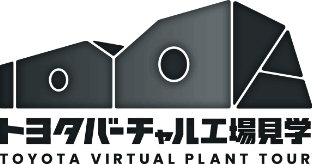TOYOTA PRODUCTION SYSTEM
For the Benefit of Others
Making ever-better products for our customers,
delivering quality products and at the best price.
And always putting people first, making the work easier and less burdensome.
Creating
no defects
To produce or transport
only what is needed,
when it is needed, and in
the amount needed.
Jidoka or
Autonomation
In the Toyota Production System, the term Jidoka or autonomation is used instead of automation.
Jidoka is the concept of preventing defective products by automatically stopping a machine when an abnormality occurs. This eliminates the need for a person to watch over machines all the time, thereby improving productivity.


Exploring Autonomation
When a problem is identified, the worker presses a button called a call button that turns on an electric board called an Andon board to inform the leader. Work won't resume until the problem is resolved.
Exploring Autonomation
This Poka-yoke is linked to the electric screwdriver used by the worker to check for any loose screws that need tightening. If there is a problem, a red lamp will alert the worker, helping prevent defective products.

How did the idea of Jidoka come about?
Born from a Desire to Help Make his Mother's Job Easier
Sakichi Toyoda, the founder of the Toyota Group, watched his mother weaving a loom and began researching looms to see if he could make weaving easier. He then invented a loom that could be operated with one hand and even one that stopped automatically when the vertical yarn was shredded or ran out. The desire not only to improve efficiency, but also to "make someone's job easier" is the basis of Jidoka.
Just-in-Time
Just-in-Time is the concept of delivering products at an appropriate price in a timely manner by shortening the production time after an order is placed, and minimizing generation or holding of stock. We also make sure that necessary parts arrive in the right timing and in the order to be used.


Exploring Just-in-Time
This is a production system where parts made in the preceding process are not delivered to the following process, but rather the following process goes to the preceding process to pull the parts that have already been used. It is facilitated by Kanban card.
Exploring Just-in-Time
In pulling parts by the assembly plant, Kanban cards are used to coordinate with the supplier to ensure that the required quantity arrives when needed.

How did the idea of Just-in-Time
come about?
Catching Up with the High Productivity
in the United States
After witnessing the American automobile society in the 1920's, Kiichiro Toyoda, the founder of Toyota Motor Corporation, decided to manufacture passenger car with limited funds and scarce resources, he advocated for a Just-in-Time system, in which nothing is wasted. After the World War II, in order to catch up with the productivity of the U.S., Toyota established a new production system in which the next process in line pulls from the prior process. The idea came in part from supermarkets, which only refill goods that have been sold.
 Kiichiro Toyoda Departs to Europe and the U.S. from the Port of Yokohama
Kiichiro Toyoda Departs to Europe and the U.S. from the Port of Yokohama




